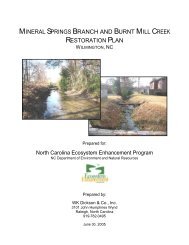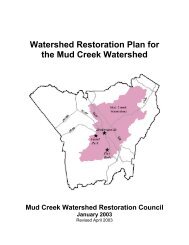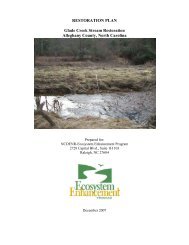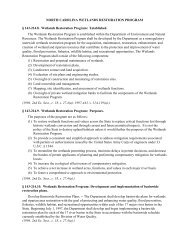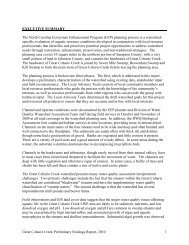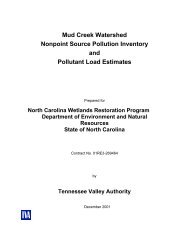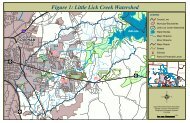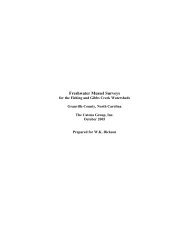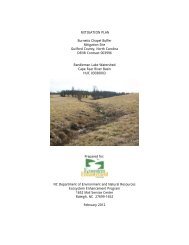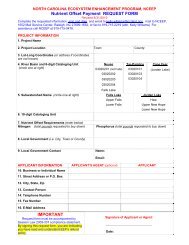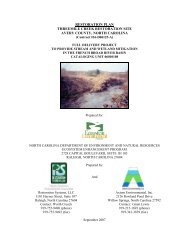Watershed Restoration Plan for the White Oak River Basin i
Watershed Restoration Plan for the White Oak River Basin i
Watershed Restoration Plan for the White Oak River Basin i
Create successful ePaper yourself
Turn your PDF publications into a flip-book with our unique Google optimized e-Paper software.
Targeted Local <strong>Watershed</strong>s in Subbasin 03<br />
Table 4.3 summarizes pertinent in<strong>for</strong>mation <strong>for</strong> <strong>the</strong> two Targeted<br />
Local <strong>Watershed</strong>s in this subbasin. Figures 4.8 and 4.9 depict <strong>the</strong><br />
major hydrologic and resource features <strong>for</strong> <strong>the</strong> two TLWs.<br />
Newport <strong>River</strong>, Black Creek and Mill Creek <strong>Watershed</strong> [HU<br />
03020106030030]<br />
This 20-square mile watershed includes a stretch of <strong>the</strong> Newport<br />
<strong>River</strong> and its tributaries just downstream of Newport, extending into<br />
<strong>the</strong> estuarine [class SA] waters of <strong>the</strong> Newport <strong>River</strong> due north of<br />
Morehead City. It encompasses approximately 300 acres of impaired<br />
shellfishing waters. The watershed is 99% <strong>for</strong>ested, including large<br />
tracts of <strong>for</strong>mer pine plantation (ditched/drained pine flats and pocosins) which could provide<br />
good wetland restoration opportunities. The Division of Coastal Management (DCM) classifies<br />
much of <strong>the</strong> existing or altered wetland areas within this watershed as having exceptional or<br />
substantial "functional significance", in terms of <strong>the</strong>ir water quality, hydrology, and habitat<br />
functions (DCM, 1999). Several local resource professionals commented on <strong>the</strong> development<br />
threat to <strong>the</strong> <strong>for</strong>mer pine plantation areas in this watershed, in addition to <strong>the</strong> encroaching<br />
development and new home sites [and septic systems] being constructed in <strong>the</strong> marginal (hydric)<br />
soils along Mill Creek and north of <strong>the</strong> Newport <strong>River</strong>. The NC Coastal Land Trust holds an<br />
easement on riparian lands amounting to over 1,100 acres along Black Creek and <strong>the</strong> Newport<br />
<strong>River</strong> in this watershed. According to one resource professional, <strong>the</strong>re is at least one 319-funded<br />
agricultural project in <strong>the</strong> watershed.<br />
Gales Creek, Jumping Run Creek and <strong>the</strong> ICWW <strong>Watershed</strong> [HU 03020106030060]<br />
This relatively small local watershed (only 7.6<br />
square miles in area) includes approximately 50<br />
acres of impaired shellfishing waters attributed to<br />
fecal coli<strong>for</strong>m contamination in storm water runoff.<br />
Under <strong>the</strong> direction of NC Sea Grant, Section 319<br />
and CWMTF monies have been used to monitor<br />
water quality in <strong>the</strong> watershed and to implement<br />
demonstration-scale BMPs <strong>for</strong> urban planning and<br />
storm water management. The NCWRP, in<br />
collaboration with <strong>the</strong> Carteret-Craven Electric<br />
Cooperative (CCEC), is restoring 4.4 acres of<br />
wetlands along Jumping Run Creek adjacent to <strong>the</strong> CCEC facility [photo at right]. This project<br />
is designed to restore headwater wetlands, provide retention and treatment of freshwater runoff<br />
from <strong>the</strong> upper Jumping Run Creek watershed, and reduce storm water inputs of nutrients and<br />
fecal coli<strong>for</strong>m bacteria into closed shellfishing waters in <strong>the</strong> watershed. This project should<br />
contribute to <strong>the</strong> eventual removal of shellfish harvesting restrictions in local waters. It also represents a<br />
unique partnership between public agencies and private industry to work toward local water quality<br />
improvement. As this watershed faces future development pressures and expanding land clearing<br />
activities around Newport and Highway NC-24, identifying it as a Targeted Local <strong>Watershed</strong> is intended<br />
to encourage additional water quality and habitat restoration initiatives here.<br />
<strong>Watershed</strong> <strong>Restoration</strong> <strong>Plan</strong> <strong>for</strong> <strong>the</strong> <strong>White</strong> <strong>Oak</strong> <strong>River</strong> <strong>Basin</strong> 33




